|
Here are a few of this week's stories from the Michigan Department of Natural Resources:
See other news releases, Showcasing the DNR stories, photos and other resources at Michigan.gov/DNRPressRoom.
PHOTOS: Larger, higher-res versions of some of the images used in this email (kayaking and autumn leaves) are available in the DNR's public image gallery. The screech owl image is courtesy of the U.S. Fish and Wildlife Service National Digital Library.

The newest episode of the DNR Wildlife Division's "Wildtalk" podcast is now available and, just in time for Halloween, the October show has great information about some of Michigan’s creatures of the night: eastern screech owls and striped skunks. You’ll also hear about how to enjoy and use seasonal decorations in ways that don’t harm or affect wildlife. (Read more on that in the story below.)
DNR wildlife biologist Terry McFadden stops by to shed some light on fall happenings for wildlife in the southeast region of the state, and Pete Kailing, a senior wildlife biologist for the DNR in the southwestern Lower Peninsula, shares an overview of this month’s hunting and trapping opportunities.
Visit the "Wildtalk" webpage for the latest episode, as well as show notes and links to past episodes. Questions about the podcast? Email DNR-Wildlife@Michigan.gov.
|

With Halloween just around the corner, you’re sure to see pumpkins, ghosts, cornstalks and more adorning homes and businesses in your neighborhood. If you’re planning to join the fun, take a moment before purchasing supplies or decorating outside to consider if your display could attract or harm wildlife.
Rachel Lincoln, a wildlife outreach coordinator with the DNR Wildlife Division, said it can be as simple as being aware that pumpkins, gourds, potted plants and flowers may bring deer, squirrels, birds and other animals to your property, or avoiding the use of paint, bleach or other chemicals on pumpkins because those substances can be harmful to wildlife that eat the pumpkins.
Beyond that, it’s about taking a few extra precautions.
“Be sure your decorations are clean and scent-free. Every October, we get reports of wildlife with Halloween candy buckets or decorations stuck on their heads or feet from trying to reach the sweets that were inside,” Lincoln said. “It’s easy to prevent this by cleaning up candy wrappers or spills around outdoor decorations and not placing food-related decor that might lure animals.”
Here are other tips for wildlife-safe decorations:
- Be cautious with fake cobwebs and string lights. Placing these decorations over bushes or between trees can accidentally entangle bats and birds flying through.
- Position these items away from natural flight paths or wildlife habitats to reduce the risk.
- After the holiday, check decorations for any small critters that may have used them as shelter, such as birds, squirrels or insects, to ensure you don’t accidentally trap or harm them.
Questions? Contact Rachel Lincoln at 517-243-5813.
|

Whether you live on a lake, enjoy a secret fishing spot or escape the daily grind at a serene water haven in the woods, you already know that lakes provide big benefits to mental and physical health and deserve our appreciation and attention. You can discover even more connections through an upcoming Michigan State University Extension opportunity.
A nationally recognized, award-winning, six-week class for anyone with a passion or curiosity for inland lakes, MSU Extension’s Introduction to Lakes Online course is full of information and inspiration for lakefront property owners, local government officials, lake managers, educators and others. Led by Extension educators and state agency personnel, it covers lake ecology, watersheds, shorelines, water law, aquatic plant management and community involvement.
Registration and course information
The 2025 course runs Jan. 21 to March 12. Register by Jan. 6 for the early-bird discounted rate of $95 per person; after that, the cost is $115. Registration closes Jan. 28. Course details and scholarship information are available on the Introduction to Lakes Online course webpage.
More than 2,000 people across the country have taken the annual course since it was first offered online in 2015. Participants regularly praise the content and level of interaction they enjoy with instructors and other students.
Students will experience:
- Week-by-week, 24/7 access to six online units, complete with prerecorded video lectures, interactive activities, other resources and quizzes.
- Lively discussion forums and biweekly webinars with classmates and instructors. Ask-an-expert webinars let you learn from experts at the DNR, MSU and the Michigan Department of Environment, Great Lakes, and Energy.
Upon finishing the course, students receive a certificate of completion. They also can receive continuing education credits, including 16 Michigan Department of Agriculture and Rural Development Pesticide Applicator Re-Certification credits.
Questions? Contact Paige Filice (MSU Extension), 517-676-7291 or Joe Nohner (DNR), 517-599-6825.
|

If raking and bagging fall leaves is an outdoor chore you dread, listen up! There are some good reasons to scratch this from your to-do list.
Where do little critters go during the winter? Many spend it in/under the leaves. Moths, bees, salamanders, turtles and many other species rely on fallen leaves for different stages of their lives, either hiding among the foliage or eating the leaves.
A few years back, one of our Showcasing the DNR stories covered the benefits of leaving your lawn "as is" (or close to it) during the colder months. As you prep your outdoor spaces for winter, try not to be too orderly – leaving a bit of natural chaos is just how many species like it.
Read the full story for more tips on handling your leaves.
|
 See more pictures by Michigan state parks photo ambassadors at Instagram.com/MiStateParks. For more on the program, call Stephanie Yancer at 989-274-6182. (This photo is by Samantha Bohon, for the Michigan DNR, at South Higgins Lake State Park's harvest festival in Roscommon County.)
|